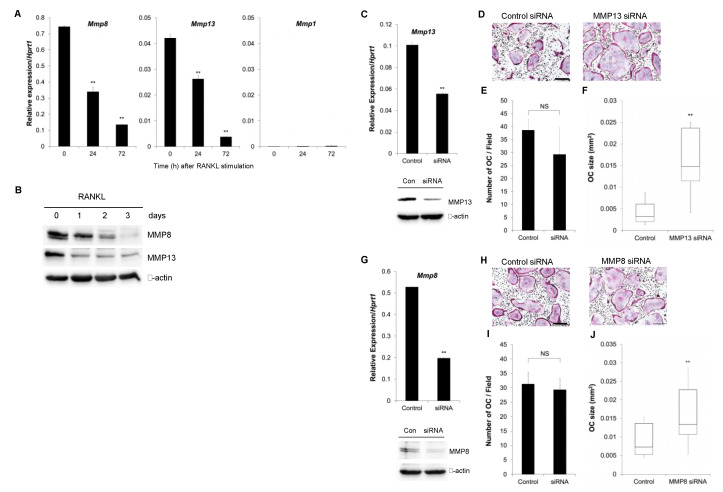Figure 1.
The role of matrix metalloprotease (MMP)8 and MMP13 on osteoclast differentiation. (A) Bone marrow macrophages (BMMs) were cultured in the presence of macrophage-colony stimulating factor (M-CSF) and receptor activator of nuclear factor κB ligand (RANKL) for 3 days, and the expression of collagenases was determined by real-time RT-PCR analysis. (B) BMMs were cultured as in (A) were lysed and subjected to Western blot analyses. (C) BMMs were cultured in the presence of MMP13-siRNA for 2 days and the expression of MMP13 was confirmed by real-time RT-PCR analysis (upper panel) and Western blot (lower panel). (D) Cells in (C) were further cultured in the presence of M-CSF and RANKL for 5 days and stained for tartrate-resistant acid phosphatase (TRAP) activities. (E) The number of TRAP-positive osteoclasts with more than 3 nuclei was counted from experiments in (D). (F) The size of osteoclasts was measured from the experiments in (D). (G) The MMP8 mRNA and protein expression were examined after culturing BMMs with MMP8-siRNA for 2 days. (H) Cells in (G) were further cultured in the presence of M-CSF and RANKL for 5 days and stained for TRAP activities. (I) The number of osteoclasts was counted from experiments in (H). (J) The osteoclast size from the experiments in (H) was measured. Data are mean ± SD of triplicate experiments representative of three independent experiments. **, p < 0.01 versus control. Scale bars indicate 100 μm.

